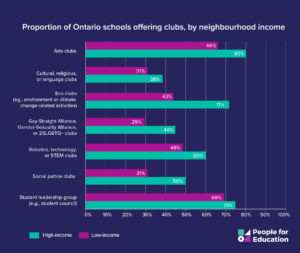Inequities persist
New report shows not all Ontario students have access to broader learning opportunities
Findings from People for Education’s latest report show that while most extracurricular activities and broader learning opportunities have resumed since being paused during the pandemic, students’ access varies substantially depending on where they live.
The data also show that fundraising, which supports many of these activities, has not returned to pre-pandemic levels, varies widely depending on median neighbourhood income, and may be fueling already existing inequities in access to extracurriculars and other school activities.
The report, based on data from People for Education’s 2022-2023 Annual Ontario School Survey, includes responses from 1,044 principals from all of Ontario’s 72 publicly funded school boards.
Participating in broader learning opportunities builds key skills for long-term success
The report points out that broader learning opportunities including arts, sports, and clubs provide students with the chance to develop essential 21st century skills such as collaboration, persistence, critical thinking, and leadership. These activities have also been shown to positively affect students’ mental and emotional well-being, decrease time spent on screens, and improve students’ self-confidence and feelings of belonging.
Access to extracurricular and school activities depends on where students live
Data from the report show differences in the availability of extracurricular activities and clubs depending on the median family income of the school neighbourhood and whether the schools is in an urban or rural area. In 2022/23:
- 80% of schools in high-income areas offered arts clubs compared to 66% of schools in low-income areas.
- 44% of high-income schools had Gay Straight Alliances, vs 29% of low-income schools.
- 40% of urban schools vs 29% of rural schools offered cultural, religious, or language clubs
Challenge: we are located in one small community but serve six small communities plus points in between. After-school transportation is not available and limits after school activities.
Secondary school principal, Northern Ontario
Some activities have not returned to pre-pandemic levels
Arts-based opportunities, which were greatly reduced during the pandemic, have recovered, but to a lesser extent than other opportunities, like sports, clubs, and field trips. In 2022/23:
- 55% of elementary and 74% of secondary schools provided opportunities for students to learn an instrument during school hours, down substantially from 84% and 90% respectively in 2019/20.
- 66% of elementary and 83% of secondary schools offered opportunities for students to participate in a performance/exhibition compared to 84% and 90% respectively in 2019/20.
Teachers are having difficulty meeting the socio-emotional needs of students and are exhausted; therefore, they are not volunteering for as many things outside of their classroom programs.
Elementary school principal, Greater Toronto Area
Decline in fundraising may increase inequities in access to extracurriculars and clubs
Funding to cover the cost of most broader opportunities comes from school budgets, rather than provincial funding. Many schools rely on fundraising to augment their budgets, but the proportion of schools that report fundraising is down significantly from pre-pandemic numbers. In 2022/23:
- 88% of elementary schools and 70% of secondary schools reported fundraising, compared to 99% and 88% respectively in 2019/20.
- The average amount fundraised in high-income schools was almost three times higher than that raised in low-income schools ($10,423 compared to $3,757 per school).
Many more families are experiencing financial hardship. It is becoming more and more difficult to fundraise. Costs for co-curricular activities have skyrocketed, but the per pupil allocation from the board/ministry has not changed to reflect inflation. We are doing more with less money.
Secondary school principal, Central Ontario
The findings also highlight that there were major differences in what schools in high-income neighborhoods fundraised for vs. those in low-income neighborhoods. In 2022/23:
- 51% of high-income schools fundraised for library resources, compared to 21% of low-income schools.
- 52% of high-income schools fundraised for technology, compared to 25% of low-income schools.
Recommendations for change
The report includes two overall recommendations to the province:
- Develop policy and funding that recognizes the far-reaching benefits that extracurricular and school activities provide for students and ensures that all students have equitable access to these vital components of a quality education.
- Convene a Health and Education Task Force including experts, practitioners, and students to provide input on government policy before it is implemented, and to help design new policy and funding models to support things like extracurricular activities, arts and sports, and clubs.
Read the report
ENGLISH | FRENCH | INFOGRAPHIC
